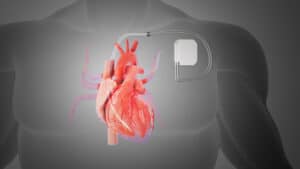 If you have a pacemaker and/or an ICD (implantable cardiac defibrillator) or know someone who has a pacemaker and/or ICD, please read this important article. Each year, approximately 2.5 million individuals all over the world will die due to the unavailability of pacemakers and implantable cardiac defibrillators. This does not need to be the case, however, as reclaimed pacemakers can save many lives! Not only can you donate your pacemaker to another human after your death, but you can also donate your pacemaker and/or ICD to save the life of a dog or other animal. For simplicity, we will just talk about pacemakers for the remainder of this article, but keep in mind that everything in this article applies to both pacemakers and internal cardiac defibrillators, which are sometimes separate devices, but more often these days combined into one single device.
If you have a pacemaker and/or an ICD (implantable cardiac defibrillator) or know someone who has a pacemaker and/or ICD, please read this important article. Each year, approximately 2.5 million individuals all over the world will die due to the unavailability of pacemakers and implantable cardiac defibrillators. This does not need to be the case, however, as reclaimed pacemakers can save many lives! Not only can you donate your pacemaker to another human after your death, but you can also donate your pacemaker and/or ICD to save the life of a dog or other animal. For simplicity, we will just talk about pacemakers for the remainder of this article, but keep in mind that everything in this article applies to both pacemakers and internal cardiac defibrillators, which are sometimes separate devices, but more often these days combined into one single device.
When the Pacemaker Outlives the Patient
When someone with a pacemaker dies from old age or other causes, it doesn’t mean that the pacemaker dies along with them. In fact, in many cases, a pacemaker that is implanted in an individual by their cardiologist has much useful life remaining after the death of the patient. With proper planning in place, upon death, your pacemaker can be entered into a program to determine if it can be used again to save another life in either another country (or by an animal in need, as described in today’s Critter Corner). Unfortunately, at this time, the Food and Drug Administration (FDA), which oversees US medical devices, prohibits the use of recycled heart devices. The FDA has deemed them for “single use” only, mainly citing safety concerns. Again, they can still be donated to save lives in other countries, providing therapy that basically would not be available to many individuals in these countries at all. How does pacemaker donation work? It depends on whether the person with the pacemaker dies in a hospital and whether they have chosen to be cremated or buried. If a person dies in a hospital and the individual or their family requests removal of the pacemaker/defibrillator for donation, the hospital can remove the pacemaker.
- Cremation: If cremation is the chosen route, the pacemaker must be removed from the body before the cremation process occurs. This is because pacemakers contain lithium batteries that will explode when exposed to high heat during cremation. This can cause injuries to the funeral directors and to the cremation unit, so naturally, these units are removed and recycled.
- A crematorium typically learns if an individual has a pacemaker through information provided by the funeral home, which in turn receives this information from the deceased person’s medical records or family members.
- However, you can be proactive and plan in advance for your pacemaker to be donated after death. Or your family can decide to have your pacemaker donated after your death.
- Many people with pacemakers, and their family members, are eager to help others in need when they learn about pacemaker donation programs.
- Traditional burial: If a person is to be buried, the funeral director will typically remove the pacemakers from the body before burial, but sometimes not. Over the last few years, there has been a growing trend to remove ALL pacemakers from bodies that will be buried, keeping them out of the ground and preventing future ecological contamination that will happen in years when everything buried breaks down and returns to the earth. Since removal is better for the environment, why not recycle and reuse the pacemaker to save a life?
Programs Where You Can Donate Recycled Pacemakers Internationally
According to researchers at the University of Michigan, almost 90 percent of individuals with pacemakers would donate their device to others in need if given the chance. The project, My Heart Your Heart (MHYH), is part of the University of Michigan Hospital and has existed for more than a decade. The basis of the program revolves around reclaiming and testing pacemakers collected from funeral homes and using them to provide a lifesaving solution to people who need them the most. The nonprofit organization MHYH collects used pacemakers and defibrillators from funeral homes and then works with a contractor to sterilize the devices according to specific protocol outlined by the FDA. “The refurbished devices are ultimately prepared for shipment to certain foreign governments that have explicitly requested them,” said Dr. Thomas Crawford, a cardiologist and director and principal investigator for My Heart Your Heart.
According to Dr. Stephen Vlay, a professor of medicine at New York’s Stony Brook University and a proponent of recycling devices, “[i]n the United States, we’re fortunate to live in a society where essential emergency medical care is available regardless of ability to pay,” he said. “But if you’re in underserved areas in Africa, Asia, or Latin America and you need a pacemaker, and you have no money, you will have to survive with a heartbeat of 30 beats a minute until you die. And that may be much sooner rather than later.” Vlay also said, “(p)acemakers average around $5,000, defibrillators cost about three times that much. Neither type of device should be simply thrown away because of their lithium ion batteries. If each of the 5,000 plus hospitals in the US explants 10 viable devices and discards them, that’s approaching (an average) $500 million dollars a year in viable medical equipment that gets destroyed.” Avoiding that kind of waste and helping those in need helped inspire the My Heart Your Heart project.
The My Heart Your Heart project stresses that most people in underserved areas struggle to make enough money for basic living expenses such as food and housing, let alone effective medical treatment, and, in some cases, they have no choice but to leave their cardiac pacing issues ignored. These are the areas in which a recycled pacemaker can help.
Other nonprofits have recognized the value of a reclaimed pacemaker and how it can save lives. My Heart Your Heart collaborates with World Medical Relief to aggressively take reclaimed pacemakers using the MHYH protocol and implant as many of them as possible to save lives. Another organization is Arrhythmia Alliance. In 2023, doctors working with these international organizations implanted more than 400 pacemakers in various African countries with much success, saving the lives of those who received them. In 2024, they had hoped to implant close to 650 units.
For more details on pacemakers being donated to dogs, please read today’s Critter Corner!
Can Neurostimulators Used for Parkinson’s Deep Brain Stimulation Be Donated, as Well?
Deep brain stimulation (DBS) is a surgical procedure for Parkinson’s that can help ease motor symptoms and decrease medication needs in some people. In DBS surgery, the surgeon places thin wires called electrodes into one or both sides of the brain that control movement. Once the electrodes are in place, the surgeon connects them to a battery-operated device (similar to a cardiac pacemaker), which usually is placed under the skin below the collarbone. This device, called a neurostimulator, delivers continuous electrical pulses through the electrodes. Most people are able to decrease (but not completely discontinue) Parkinson’s drugs after DBS.
Unfortunately, no information is available about whether neurotransmitters can be donated once a loved one with Parkinson’s dies or how much of a need there is. I hope to provide an update if and when more information becomes available about this. Please note that Parkinson’s brains can be donated for research, and donation is encouraged by Parkinson’s research groups.
What Other Implants Can Be Donated?
Implants such as defibrillators, artificial joints, metal plates, and dental work have become increasingly common. In the past, these implants were buried, incinerated, or sent to landfills after a death. Today many can be recycled, extracted, processed, and ultimately reused in some form. For example, the metal in surgical and dental implants can be melted down and reconstituted as new implants. Reusing the materials can also help the environment and save valuable natural resources. Here are some examples:
- Hearing aids: Used hearing aids can be donated to organizations that refurbish and sanitize them for people who can’t afford new ones
- Dental implants: Organizations such as CANA (Cremation Association of North America) and ICCFA (International Cemetery, Cremation and Funeral Association) support and encourage medical implant recycling, for the environmental benefit, for charitable donations, or for use by those in need in other countries.
- Prosthetic limbs: Many prosthetic arms and legs contain titanium, an incredibly hard and durable metal that does not break down in a cremation. Limbs for Life provides information on donating prosthetic devices for use overseas
How Do You Designate That You’d Like to Donate Your Pacemaker?
To learn more about donating a pacemaker through My Heart Your Heart, please download the MHYH Device Donor Information Sheet. If you are ready to donate a pacemaker through My Heart Your Heart, there is a form on their website that should be filled out, as well. Also important is putting your planning in place to ensure that the pacemaker donation, other internal medical device donations, and organ donations occur according to your wishes.
Document Your Wishes in Your Advance Medical Directive
An Advance Medical Directive authorizes another person to make decisions with respect to your medical care in the event that you are physically or mentally unable to do so. Whether or not you feel strongly about pacemaker donation or organ donation, it is important to make your intentions known in an Advance Medical Directive if you want your wishes to be honored.
Our 4 Needs Advance Medical Directive® includes an After-Death Directive that addresses organ donation in detail and allows you to stipulate if you want your pacemaker and/or other internal medical devices donated, and if desired, which organs you would want donated (for example, some people want to donate internal organs, but not skin and bones, which are actually two of the most desired types of donor tissue) and even name intended recipients if perhaps you have family members with kidney disease or some other organ disease who might in the future be in need of a transplant. Our 4 Needs Advance Medical Directive® also enables you to set forth your preferences with regard to funeral arrangements and disposition of remains.
In your 4 Needs Advance Medical Directive®, you can also appoint an agent and give that person the power to consent to medical and health care decisions on your behalf. This person can decide whether to withhold or withdraw a specific medical treatment or course of treatment when you are incapable of making or communicating an informed decision yourself. Our 4 Needs Advance Medical Directive® also contains a proprietary Long-Term Care Directive® that allows you to address numerous issues that arise if and when long-term care is needed and you’re unable to communicate your wishes. In our “Near-Death Directive,” you indicate your wishes concerning the use of artificial or extraordinary measures to prolong your life in the event of a terminal illness or injury.
If you have not done Incapacity Planning (including our 4 Needs Advance Medical Directive® and Financial Power of Attorney), Estate Planning, or Long-Term Care Planning, or if you have a loved one who is nearing the need for long-term care or already receiving long-term care, please contact us to schedule an appointment.
Fairfax Estate Planning: 703-691-1888
Fredericksburg Elder Law: 540-479-1435
Rockville Elder Care: 301-519-8041
DC Medicaid Planning: 202-587-2797












